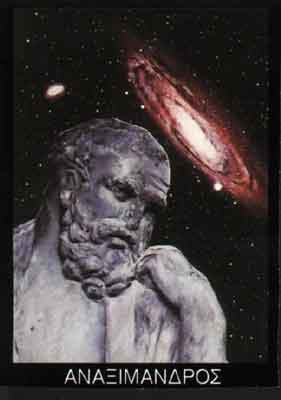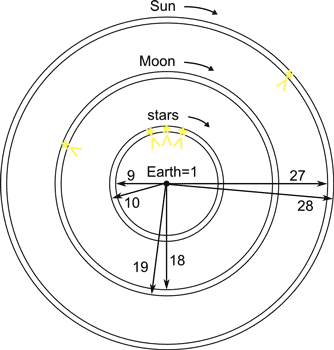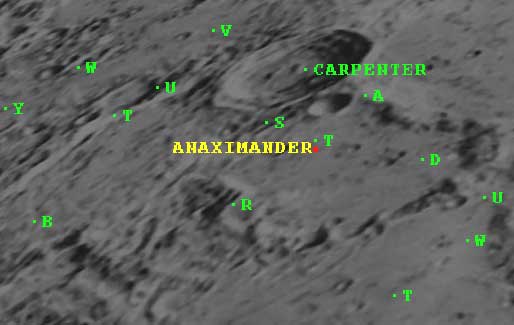.
“They say that when he sang, the children laughed; and that he, hearing of this, said, "We must then sing better for the sake of the children." Diogenes Laertius, Life of Anaximander

Anaximander (Greek: Αναξίμανδρος )(c.610 BCc. 546 BC), also known as Aniximander, was the second of the physical philosophers of Ionia, a citizen of Miletus, a companion or pupil of Thales, and teacher of Anaximenes of Miletus. Little is known of his life and work. Aelian makes him the leader of the Milesian colony to Amphipolis, and hence some have inferred that he was a prominent citizen. The computations of Apollodorus of Athens have fixed his birth in 611, and his death shortly after 547 B.C.
Ancient sources represent him as a successful student of astronomy and geography, and an early proponent of exact science. He has also been said to have introduced such astronomical instruments as the sundial and the gnomon to ancient Greece[1]. Furthermore, he is credited with having created the first map of the world, which was circular in form and showed the known lands of the world grouped around the Aegean Sea at the center and all of this was surrounded by the ocean.
Cosmology and the apeiron
Anaximander's reputation is due mainly to a cosmological work, little of which remains. Aristotle told us (Metaphysics, I III 3-4) that the Presocratics were searching for the "element" of which all things are made. This is the problem of origin, the "beginning", or the first principle (arche, a word first found in Anaximander's writings, and which he probably invented, but which is analogous to our "atom" or "quark"). While each Presocratic philosopher gave a different answer as to what this beginning was (water for Thales, air for Anaximenes, fire for Heraclitus), from the few extant fragments we learn that Anaximander took the beginning or first principle to be an endless, unlimited primordial mass (apeiron), subject to neither old age nor decay, which perpetually yields fresh materials from which everything we can perceive is derived.
Unlike other Presocratics he never defined this principle precisely, and it has generally (e.g. by Aristotle and Augustine) been understood as a sort of primal chaos. It embraced the opposites of hot and cold, wet and dry, and directed the movement of things, by which there grew up all of the host of shapes and differences which are found in "all the worlds"--as he believed there were many.
Out of the vague and limitless body there sprang a central mass — this earth of ours, cylindrical in shape, poised equidistant from surrounding orbs of fire, which had originally clung to it like the bark round a tree, until their continuity was severed, and they parted into several wheel-shaped and fire-filled bubbles of air.
Man himself had come into being by like transmutations. Mankind was supposed by Anaximander to have sprung from some other species of animals, probably aquatic. For, he thought, man with his extended infancy could not have survived, originally, in the manner he does presently. For this, even though he had no theory of natural selection, some people consider him to be evolutionary theory's most ancient proponent. The theory of an aquatic descent of man was re-conceived centuries later as the aquatic ape hypothesis.
Anaximander offered up the theory of the apeiron in direct response to the earlier theory of his teacher, Thales, who had claimed that the primary substance was water. Anaximander reasoned that water cannot embrace all of the opposites found in nature — for example, water can only be wet, never dry — and therefore, it can not be the one primary substance. Nor could any of the other candidates, so Anaximander postulated the apeiron as a substance that, although it could not be perceived directly, could explain the opposites he could clearly see around him.
The one surviving fragment of Anaximander was transmitted as a quote by Simplicius and could be translated as
Whence things have their origin,
Thence also their destruction happens,
According to necessity;
For they give to each other justice and recompense
For their injustice
In conformity with the ordinance of Time
Interpretations
Bertrand Russell in The History of Western Philosophy interprets the above quote as an assertion of the necessity of an appropriate balance between earth, fire, and water elements, all of which may be independently seeking to aggrandize their proportions relative to the others. Anaximander seems to express his belief that a natural order ensures balance between these elements, that where there was fire, ashes (earth) now exist. Anaximander's Greek peers echoed this sentiment with their belief of natural boundaries that not even their Gods could operate beyond.
Nietzsche, in his Philosophy in the Tragic Age of the Greeks, claimed that Anaximander was a pessimist. Anaximander asserted that the primal being of the world was state of indefiniteness. In accordance with this, anything definite has to eventually pass back into indefiniteness. In other words, Anaximander viewed "...all coming-to-be as though it were an illegitimate emancipation from eternal being, a wrong for which destruction is the only penance." (Ibid., § 4) The world of individual objects, in this way of thinking, has no worth and should perish.

Relative distances of the stars, moon and soon. The numbers are as suggested inspired by Hesiod's statement in Theogony: For a brazen anvil falling down from heaven nine nights and days would reach the earth upon the tenth: and again, a brazen anvil falling from earth nine nights and days would reach Tartarus upon the tenth. The numbers 18 and 27 are just multiple of 9 as an indication of farther and farthest.
Known Works
On Nature, circa ?
Subject : Philosophy
Referenced in Simplicius in Phys., p. 24, 13sq.
Authenticity Likely
Map, circa ? (lost)
Subject : (First?) Map of his Known World
Referenced in Agathemerus, Geographie information
Authenticity : Likely
Some of Anaximander's ideas were also preserved in Theophrastus's (lost) history of philosophy, and re-quoted by later authors.
He also was the first discoverer of the gnomon; and he placed some in Lacedaemon on the sun-dials there, as Favorinus says in his Universal History, and they showed the solstices and the equinoxes; he also made clocks. He was the first person, too, who drew a map of the earth and sea, and he also made a globe; Diogenes Laertius, Life of Anaximander
It is clear then from these considerations that the inquiry concerns the physicist. Nor is it without reason that they all make it a principle or source. We cannot say that the infinite has no effect, and the only effectiveness which we can ascribe to it is that of a principle. Everything is either a source or derived from a source. But there cannot be a source of the infinite or limitless, for that would be a limit of it. Further, as it is a beginning, it is both uncreatable and indestructible. For there must be a point at which what has come to be reaches completion, and also a termination of all passing away. That is why, as we say, there is no principle of this, but it is this which is held to be the principle of other things, and to encompass all and to steer all, as those assert who do not recognize, alongside the infinite, other causes, such as Mind or Friendship. Further they identify it with the Divine, for it is ‘deathless and imperishable’ as Anaximander says, with the majority of the physicists. Aristotle Physics III
About 2500 years ago, Anaximander said that life originated in water and that simple forms preceded complex forms. Democritus thought that the simplest forms of life arose from a kind of primordial ooze [Carl Sagan, Cosmos ].
Anaximander considered life (in the form of a fish) to be originated from the moisture that initially covered the Earth. Also initially men were generated from fishes. One may argue that this has nothing to do with evolution theory but at least it accepts the idea that organisms are not static objects but change.
It is interesting to note that apeiros means not only infinite but it can also mean 'that which is not experienced'.

ANAXIMANDER crater
c. 67 km diameter
2800 mt height walls
Longitude: 51.3° West
Latitude: 66.9° North
Quadrant: North-West
Area: Moon North-North-West limb
Observation period: 4 days after First Quarter or 3 days after Last Quarter
Minimal Instrument: 50 mm refractor
Anaximander crater on the Moon, at 66.9N, 51.3W, is named after him.
The asteroid 6006 Anaximandros is also named after him.
Footnotes
- ^ Diogenes Laertius - Anaximander
Links
- http://www.dirkcouprie.nl/Anaximander.html
|
Presocratic Philosophers series Thales | Anaximander | Anaximenes | Pythagoras | Philolaus | Archytas | Empedocles | Heraclitus | Parmenides | Zeno of Elea | Melissus | Xenophanes | Anaxagoras | Leucippus | Democritus | Protagoras | Gorgias | Prodicus | Hippias | Pherecydes |
G. S. Kirk, J. E. Raven, M. Schofield , The Presocratic Philosophers: A Critical History with a Selection of Texts , Cambridge University Press;
Aglaonice Agrippa Anaximander Andronicus Apollonius Aratus Aristarchus Aristyllus Attalus Autolycus Bion Callippus Cleomedes Cleostratus Conon Eratosthenes Euctemon Eudoxus Geminus Heraclides Hicetas Hipparchus Hippocrates of Chios Hypsicles Menelaus Meton Oenopides Philip of Opus Philolaus Posidonius Ptolemy Pytheas Seleucus Sosigenes of Alexandria Sosigenes the Peripatetic Strabo Thales Theodosius Theon of Alexandria Theon of Smyrna Timocharis
Greeks:
A - B - C - D - E - F - G - H - I - J - K - L - M -
N - O - P - Q - R - S - T - U - V - W - X - Y - Z
| Ancient Greece
Science, Technology , Medicine , Warfare, , Biographies , Life , Cities/Places/Maps , Arts , Literature , Philosophy ,Olympics, Mythology , History , Images Medieval Greece / Byzantine Empire Science, Technology, Arts, , Warfare , Literature, Biographies, Icons, History Modern Greece Cities, Islands, Regions, Fauna/Flora ,Biographies , History , Warfare, Science/Technology, Literature, Music , Arts , Film/Actors , Sport , Fashion --- |
Retrieved from "http://en.wikipedia.org"
All text is available under the terms of the GNU Free Documentation License

